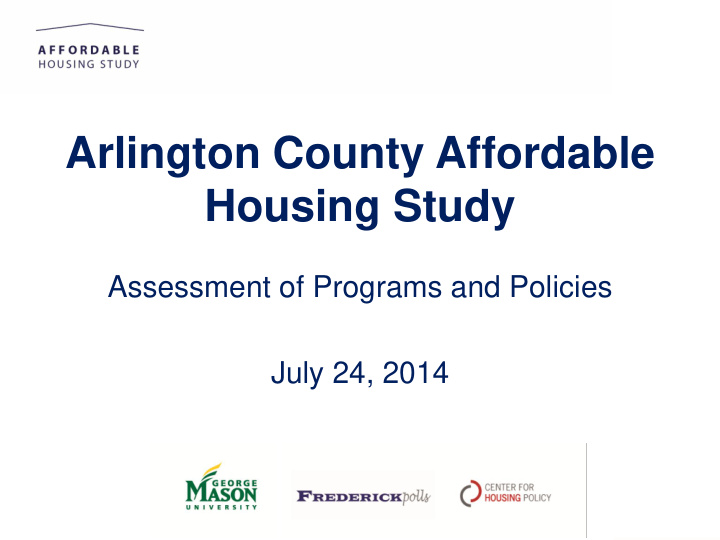



Arlington County Affordable Housing Study Assessment of Programs and Policies July 24, 2014
Housing Programs and Policies • Rental Housing Development Assistance • Land Use Policies • Tenant Assistance Funds • Homeownership Programs • Housing Services Programs
Rental Housing Development Assistance • Target is 350 rental CAFs per year • Produced average of 189 from FY10-FY14 • Majority of funding from developer contributions • Meeting goals for family units, but few 3BR • Most CAFs since 2009 in Columbia Pike corridor, but most replaced MARKs • Challenged by likely future funding reductions and rising subsidy costs.
Land Use Policies • 3,137 CAFs produced since adoption of new Affordable Housing Ordinance in 2006 • 95% of new units via cash contributions to AHIF; only 41 units were on-site ADUs – Nearly all CAFs are in separate projects, few in Metro corridors • Cash contribution amount clearly too low to steer developers to ADU option
Tenant Assistance Funds • New policy established in 2013 standardizes future TAFs • Provided assistance to 100% of qualified households in six projects; average support of $141/month • Very effective at preventing displacement
Homeownership Programs • No dedicated funding for programs • Target is 50 per year, has averaged about 10 • Little available supply due to maximum purchase price of $362,790 – Nearly all purchases have been of condos • County discontinued LNYW, APS still has it • HIP wasn’t widely used, is on hiatus • Homebuyer education is popular and effective
Housing Services Programs • Information center processes more than 1,000 calls per year • Mediation services have resolved 90% of disputes before trial • Neighborhood Strategic Area program resolves hundreds of code violations each year • These services reinforce other housing programs at a modest cost
Human Services Programs • Housing Choice Voucher (Section 8) • Housing Grants • Real Estate Tax Relief • Permanent Supportive Housing • Homeless Services • Carter-Jenkinson Memorial Homelessness Prevention Fund • Group Homes and Transitional Housing: Mental Health Populations • Transitional Housing for Substance Abusers • Residential Services and Housing for Individuals with Intellectual Disabilities • Senior Independent Living and Assisted Living
Housing Grants • Housing Choice Voucher program is not going to expand, waiting list remains closed • Housing Grants are critical to retain nearly 1,200 low-income senior households • Provides average of $575/month in assistance
Real Estate Tax Relief • More than 1,000 households use exemption, 73% claim full exemption • Essential tool for seniors to remain in their homes • Not a “free” program: $5.2M in revenue was foregone • Demand will increase as population ages
Permanent Supportive Housing (PSH) • County goal is to have 425 PSH units • Current total: 193, but 66 added since 2011 • Critical for preventing homelessness, particularly for intellectually disabled • Very hard to convince landlords to participate • No transition program for youths aging out of foster care
Homeless Services • 2008 county goal was to reduce homeless population 50% by 2015, eliminate by 2018 • Expanded services and PSH units have reduced homelessness, but more resources and regional information sharing needed • Carter-Jenkinson Fund is critical to provide immediate assistance, especially for non-rent costs
Group Homes and Transitional Housing for Mentally Ill • County operates four group homes and two transitional homes • Served 79 individuals in FY13 • Very long waiting list, as it is difficult to place departing residents – More PSH units would relieve pressure
Transitional Housing for Substance Abusers • Independence House: 14-bed facility, up to 12-month stay • Served 26 individuals in FY13 • Very hard to find landlords willing to take those leaving the program
Residential Services and Housing for Intellectually Disabled • County operates 12 group homes for ID populations • Served 21 residents, placed 9 more in PSH units • Very hard to find locations for more group homes • Group homes no longer eligible for VHDA loan program —classified as “institutional”
Senior Independent Living and Assisted Living • Culpepper Garden: 340-unit independent and assisted living • Mary Marshall Residences: 52-unit assisted living for ID/mentally ill populations • Provides alternative to nursing homes for nearly 400 residents • Has freed up space in group homes
Profile of Affordable Housing Programs in Other Jurisdictions • Alexandria • District of Columbia • Fairfax County • Montgomery County • Prince George’s County
Summary: Other Jurisdictions Local Local Rental Inclusiona Home- Local Funding Jurisdiction Housing Assistance ry Zoning ownership Sources Authority? * Alexandria Yes, owns Yes Optional, Up to 80% Developers, bonding, 1,150 units achieved AMI dedicated tax via proffers assessment, loan repayments Yes, owns Yes Mandatory, Up to 80% Recordation tax, District of 8,363 units must be on- AMI for most, condo conversion DC gov’t Columbia site if no fees, loan economic worker limit is repayments, bonding, hardship higher special appropriations Fairfax Yes, owns No Mandatory Up to 70% No dedicated source; 1,060 units for new AMI trust fund capitalized multi-family by proffers Montgomer Yes, but Yes Mandatory Up to 120% Appropriations, y phasing out for all AMI developers, bonding, public projects of loan repayments, housing 20+ units condo conversion tax Prince Yes, owns Yes, but None Up to 120% No dedicated source George’s 376 units temporary AMI and only up to 30% AMI *Local supplements to Housing Choice Vouchers for low-income renter households
Recommend
More recommend